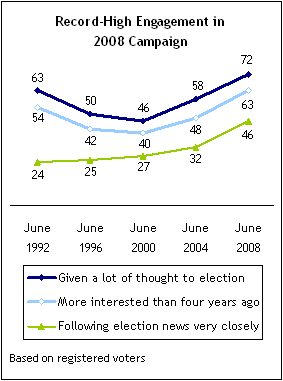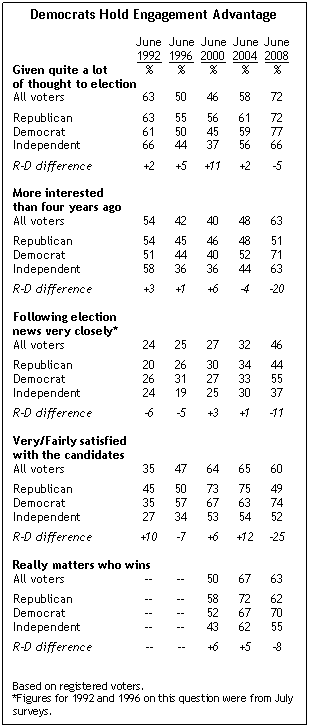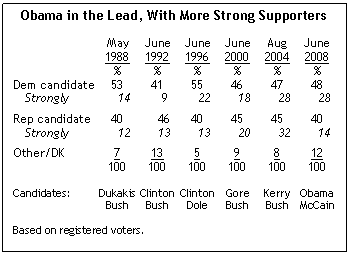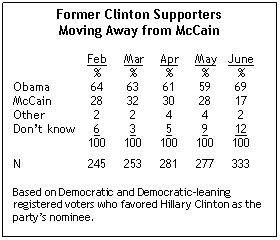Overview

The outlook for the presidential election at mid-year is substantially different than at comparable points in time in recent campaigns. First, turnout is likely to be higher this fall – perhaps much higher than in previous elections – as voter interest continues at record levels. Second, as has been the case since the start of the campaign, Democrats enjoy a substantial engagement advantage over Republicans that may significantly alter the composition of the November electorate.
Third, while there has been considerable debate about whether Hillary Clinton’s supporters will rally behind Barack Obama in the fall, it is clear that both candidates face formidable challenges in consolidating their bases. John McCain, the presumptive GOP nominee, has an enthusiasm problem. McCain engenders less strong support than does Obama and has much weaker support than George W. Bush did at this stage in his presidential campaigns.
While Obama draws more enthusiastic support, he has a unity problem. Clinton’s former supporters have moved in Obama’s direction since the primaries ended, but significant numbers remain undecided or say they might vote for McCain in the fall.
Finally, the middle of the electorate is reasserting itself in this election. There are more swing voters than there were at this point in the campaign four years ago. The proportion of self-proclaimed independents is up from 2004 and nearly half say they are uncertain about their vote choice.

The latest national survey by the Pew Research Center for the People & the Press, conducted June 18-29 among 2,004 Americans, finds greater public interest and engagement in the presidential election than during the five previous campaigns. Fully 72% say they are giving quite a lot of thought to this election – by far the highest percentage at this point in the campaign since 1988. The proportion saying they are more interested in politics this year than during the previous campaign is greater than it has been since 1992. And public interest in campaign news has been consistently higher than in recent elections.
Compared with previous election cycles, voter engagement is up among all demographic groups, but has increased more among voters under age 50 than among older voters. Uncharacteristically, the youngest voters – those under age 30 – are at least as knowledgeable, and in some cases more knowledgeable, about candidates’ positions on Iraq and abortion than are older voters.
Strong and consistent interest and engagement suggests that voter turnout will likely be high in November, as it was during this year’s primaries. The new survey finds another potential parallel between the general election and the primaries: Democratic turnout could match or perhaps exceed Republican participation in November, just as it did in most states during the primaries.
Two unprecedented findings from the new survey support a potential Democratic turnout advantage. For the first time in Center polls conducted since 1992, a greater proportion of Democrats than Republicans are expressing strong interest in the campaign. Nearly eight-in-ten Democratic voters (77%) say they are giving a lot of thought to the election, up 18 points since June 2004. Republican engagement also has increased over this period (from 61% to 72%), but for the first time somewhat fewer GOP voters than Democrats say they are giving a lot of thought to the election.
There is an even larger gap in the percentage of voters in each party saying they are now more interested in politics than they were during the previous campaign. About seven-in-ten Democratic voters (71%) report they are more interested in politics than they were four years ago, compared with barely half of Republican voters (51%). As with other measures of political engagement, in the past there were no partisan differences or Republicans held the advantage.

A second factor which may also contribute to a Democratic turnout advantage is that supporters of the Republican candidate, uncharacteristically, are less strongly committed to their choice than are supporters of the Democratic candidate. Overall, Obama leads McCain in the presidential horserace by 48% to 40%. Most voters who say they support Obama – 28% among the 48% – say they support him strongly. By contrast, only about a third of McCain’s backers say they support him strongly (14% of the 40%).
Throughout the 2004 campaign, Bush drew more strong than moderate support by margins of greater than two-to-one. Even in Bush’s first campaign, he consistently drew at least as much strong support as moderate support.
McCain is not getting as much strong support from conservatives and white evangelicals as Bush did in 2000 and 2004. While these groups support McCain over Obama by wide margins, they are doing so with less than their typical enthusiasm for GOP candidates.
There are other indications that Democrats are more enthusiastic about the election than are Republicans. Far more Democratic voters than Republican voters express satisfaction with the field of candidates (74% vs. 49%). Republican voters’ satisfaction with the candidates is now not much higher than it was in June 1996, during Bob Dole’s unsuccessful campaign (50% satisfied). In addition, 33% of Republican voters say it is hard to choose between the candidates because neither would make a good president; just 21% of Democratic voters express this view.
A positive note for the Republicans is that McCain is now winning the support of 79% of those who supported his former Republican rivals. By contrast, just 69% of former Clinton supporters say they now back Obama. The putative Democratic candidate is attracting more Clinton supporters than earlier in the campaign (59% in May). However, as many as three-in-ten former Clinton supporters now say they will vote for McCain (17%), vote for someone else (2%) or are undecided (12%).
More Swing Voters Than in ’04

Overall, McCain and Obama draw identical proportions of their own party’s voters – 82% of Republicans support McCain while the same percentage of Democrats backs Obama. Independents remain evenly split, as was the case in late May; 42% support Obama while 41% support McCain.
Compared with four years ago, a much greater share of independents are either undecided or say they might change their minds between now and the election. Nearly half of independents (46%) are undecided or may change their minds, up from 28% in June 2004.
At this stage, Obama is running better among voters under age 50 than either Kerry or Al Gore, the previous Democratic nominees. Yet Obama trails McCain by seven points (44% to 37%) among voters ages 65 and older; four years ago, Kerry led Bush by 12 points among these voters. Obama also is trailing McCain slightly among white Catholics, a key swing group that was evenly divided at this stage four years ago but that ultimately voted Republican.
Issues and Candidate Traits

The survey finds new evidence that rising energy prices are reshaping the campaign’s issues agenda. As in April, more voters want the candidates to discuss the economy than any other issue. However, about as many voters now say they want the candidates to address energy and gas prices as the war in Iraq (17% energy vs. 19% Iraq). And energy has far surpassed health care as an issue that voters want the candidates to discuss.
Obama continues to lead McCain by a wide margin as the candidate better able to improve economic conditions (51% to 31%). McCain’s strengths continue to be in foreign policy and national security: by 55% to 31%, more voters say McCain could better defend the country against terrorism and, by a more modest 47%-41% edge, say he is the candidate better able to make wise decisions about Iraq.
Voters see the candidates’ personal strengths and weaknesses in starkly different terms. Fully 74% of voters, including a solid majority of McCain supporters (58%), say that Obama rather than McCain “has new ideas.” McCain holds about a two-to-one advantage in views of which candidate is “personally qualified to be president” (55% to 27%). In previous campaigns, voters’ assessments of the candidates’ traits were more evenly balanced.
An analysis of the survey indicates that highly conservative views on race continue to be an important correlate of lack of support for Obama. In fact, it appears to be somewhat more of a correlate of choice in the general election than it was during the nomination contests.
Nonetheless, Obama’s support level among working class whites is comparable to that for Gore and Kerry, even though he struggled with this group in the primaries, and they express relatively conservative views on race in this poll. But Obama is not getting as much support as did his two predecessors from another conservative voting bloc – older white voters.
While conservative views on race continue to be a correlate of lack of support for Obama, the candidate’s lack of experience is the voters’ biggest qualm about him. Fully 40% of those who do not support Obama cite his experience as what they like least about him; at this stage during the previous two campaigns, fewer than one-in-ten voters pointed to Kerry and Gore’s experience as a negative.
In this regard, nearly twice as many voters believe the fact that Obama is new to national politics will hurt him in the election as say that the fact that he is African American will hurt him (42% vs. 22%). But even more voters (51%) say that the fact that McCain is 71-years-old will hurt his chances this fall.
Other findings
- A majority of voters (55%) give Obama a grade of A or B for convincing them to vote for him. That is a higher grade than for any Democratic or Republican candidate in the past three campaigns. By contrast, just 32% give McCain a grade of A or B.
- A small but stable minority of voters (12%) of voters believe that Obama is a Muslim. That is about the same percentage that said Obama was a Muslim in March (10%).
- Most Democratic and Democratic-leaning women voters (60%) want Obama to choose Hillary Clinton as his running mate. But voters who supported Obama in the Democratic primaries remain cool to this idea.
- A quarter of liberal Democrats say they have contributed money to a presidential candidate in the past year, about double the proportion of conservative Republicans who have donated (13%).
- Democrats who favored Clinton for the nomination remain critical of Obama. Just 35% say he is more personally qualified than McCain to be president; former Clinton supporters are split as to whether McCain or Obama could better deal with terrorist threats.
- Conservative Republican voters are decidedly less optimistic about their party’s chances in the fall than they were just a few months ago. Just 49% say McCain is mostly likely to win, down from 71% in April.
